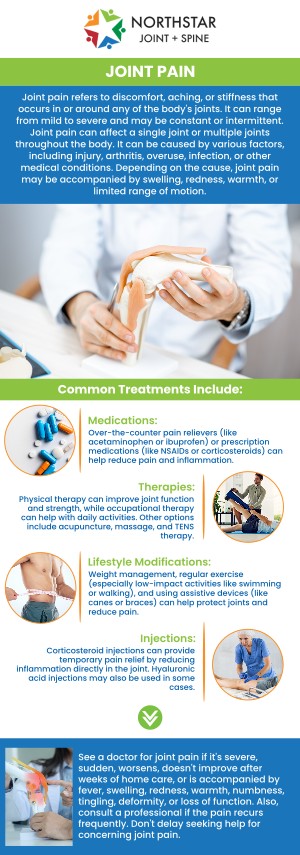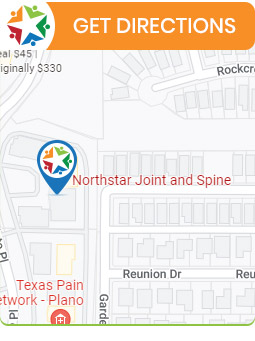Where Is SI Joint Pain Felt and How to Recognize It?
SI joint pain is typically felt in the lower back, particularly near the sacrum and pelvis. The discomfort often radiates to the buttocks, hips, or thighs, and may be one-sided. It can worsen with activities like standing for long periods, walking, or climbing stairs. Recognizing SI joint pain involves identifying these localized aches and stiffness, especially when moving or transitioning positions. At Northstar Joint and Spine, Board Certified Dr. Robert J. Nocerini, MD, provides proper diagnosis and treatment for SI joint pain, helping patients find relief through personalized care. For more information, contact us today or schedule an appointment online. We are conveniently located at 7704 San Jacinto Pl Suite #200 Plano, TX 75024.


Table of Contents:
Where is SI joint pain typically felt?
How can you tell if your pain is related to the SI joint?
What are the common causes of SI joint pain?
Can SI joint pain cause leg pain or radiate down the back?
Understanding SI Joint Pain with Dr. Robert Nocerini at Northstar Joint and Spine in Plano, TX
SI joint pain is typically felt in the lower back, near the sacroiliac joints, which are located where the spine connects to the pelvis. The pain is often localized in this area but can radiate to other parts of the body, including the buttocks, hips, and thighs. It is common to experience discomfort on one side of the body, but some individuals may feel it on both sides.
The sensation of SI joint pain is often described as sharp, stabbing, or aching, and it can be aggravated by specific movements such as standing up from a seated position, climbing stairs, or twisting the body. Prolonged periods of sitting or standing may also increase the discomfort. In some cases, the pain may be accompanied by stiffness or a restricted range of motion in the lower back and pelvis.
In addition to the pain in the lower back, SI joint issues may cause discomfort that spreads to the groin, lower abdomen, or even down the leg to the knee, though this is less common. While the intensity of the pain may vary, it tends to worsen with activities that involve bending, twisting, or bearing weight on one leg.
Effective treatment for SI joint pain often involves physical therapy to strengthen the muscles around the joint, along with other methods to reduce inflammation and improve mobility. For persistent discomfort, medical interventions such as injections or other therapies may be recommended to address the underlying cause of the pain.
If you suspect your pain is related to the sacroiliac (SI) joint, there are several signs and symptoms to look for. One of the most common indicators of SI joint pain is discomfort located in the lower back, particularly near the pelvis. The pain may be on one side, although it can occasionally affect both sides. It is often felt deep within the buttocks or around the hips, and it may radiate down into the thighs or groin.
Another key symptom of SI joint pain is discomfort that worsens with specific movements or positions. For instance, the pain may intensify when you stand up after sitting for a long time, climb stairs, or twist your body. Activities that involve shifting your weight from one leg to the other may also trigger or worsen the pain.
In addition to pain, individuals with SI joint issues may experience stiffness or a limited range of motion in the lower back and pelvis. This stiffness can make it difficult to perform certain daily activities, such as bending over, walking, or getting in and out of a car.
If you notice that your pain is localized to the lower back and pelvis, intensifies with certain movements, and is accompanied by stiffness or limited mobility, it could be related to the SI joint. Consulting with a healthcare provider can help confirm the diagnosis and provide a treatment plan, which may include physical therapy, medications, or other therapies aimed at relieving discomfort and improving mobility.
SI joint pain, also known as sacroiliac joint pain, typically arises from various factors that affect the stability and function of the sacroiliac joints. These joints connect the sacrum (the triangular bone at the bottom of the spine) with the iliac bones of the pelvis. Overuse or stress on the SI joint can lead to inflammation and pain. Activities that involve repetitive motion, prolonged standing, or heavy lifting can contribute to this condition, as they place excessive strain on the joints.
Hormonal changes, especially in women, can also play a significant role. Pregnancy, for example, increases the production of the hormone relaxin, which loosens the ligaments around the pelvis to accommodate the growing baby. While this is necessary for childbirth, it can lead to increased movement in the SI joint, causing discomfort and pain. Additionally, childbirth itself can sometimes result in temporary or long-term SI joint pain due to the strain it places on the pelvic area.
Arthritis is another common cause of SI joint pain. As individuals age, the cartilage in the joint may wear down, leading to osteoarthritis. This can cause stiffness, swelling, and pain, especially when moving or transitioning between sitting and standing. Finally, poor posture or abnormal gait can also affect the alignment of the pelvis and spine, leading to SI joint dysfunction and discomfort. It is important to address these underlying factors for effective management of SI joint pain.
SI joint pain can radiate and cause discomfort in the legs or lower back. The sacroiliac joints are located near the base of the spine, and when they become inflamed or misaligned, the pain can extend beyond the lower back region. The discomfort can sometimes radiate down the buttocks, hips, or thighs, resembling sciatica, a condition often linked to nerve irritation. The pain can also be felt in the groin area or even travel down to the knee in some cases.
The reason for this is that the SI joint is closely connected to the nerves that travel through the lower spine and pelvis. When there is dysfunction in the joint, these nerves may become irritated or compressed, causing pain to radiate down the legs. The muscles around the SI joint may also go into spasms, contributing to the discomfort in the surrounding areas, including the lower back and legs.
In addition to radiating pain, individuals with SI joint dysfunction may experience sensations of weakness or numbness in the legs, especially if the irritation extends to the sciatic nerve. The pain is often worsened by activities that require movement or pressure on the hips or spine, such as standing up from a seated position, walking, or climbing stairs. Proper diagnosis and targeted treatments, such as physical therapy or joint injections, can help alleviate the radiating pain caused by SI joint dysfunction.
Board-Certified Dr. Robert Nocerini, MD at Northstar Joint and Spine in Plano, TX, helps patients identify and manage sacroiliac (SI) joint pain with precision-based care. SI joint pain often manifests as discomfort in the lower back, hips, or buttocks, sometimes radiating to the upper thighs. Dr. Nocerini uses advanced imaging and diagnostic methods to determine the exact source of pain, ensuring a focused and effective treatment plan.
Dr. Nocerini’s goal is to restore stability and mobility through a combination of image-guided injections, therapeutic exercises, and minimally invasive procedures. His individualized care helps relieve pain and strengthen the surrounding muscles for lasting results. Patients appreciate his commitment to personalized attention and evidence-based treatments for long-term joint health and improved function. For more information, contact us today or schedule an appointment online. We are conveniently located at 7704 San Jacinto Pl Suite #200 Plano, TX 75024. We serve patients from Plano TX, Willow Bend TX, Frisco TX, Allen TX, Addison TX, North Dallas TX, and surrounding areas.

Check Out Our 5 Star Reviews


Additional Services You May Need
▸ Back Pain
▸ Shoulder Pain
▸ Chronic Pain
▸ Epidural Steroid Injections
▸ Spinal Cord Stimulation
▸ Viscosupplementation
▸ Genicular Nerve Blocks
▸ Facet Injections
▸ Joint Injections
▸ Sacroiliac Joint Injections
▸ Lumbar and Cervical
▸ Facet Medial Branch Blocks
▸ Diagnostic Nerve Blocks
▸ Medication Management
▸ Neck Pain Doctor
▸ Diabetic Peripheral Neuropathy
▸ Headaches
▸ Suboxone
▸ Botox for Migraines
▸ Peripheral Nerve Stimulation
▸ Spine
▸ Joints
▸ Muscles
▸ Bones

Additional Services You May Need
▸ Back Pain
▸ Shoulder Pain
▸ Chronic Pain
▸ Epidural Steroid Injections
▸ Spinal Cord Stimulation
▸ Viscosupplementation
▸ Genicular Nerve Blocks
▸ Facet Injections
▸ Joint Injections
▸ Sacroiliac Joint Injections
▸ Lumbar and Cervical
▸ Facet Medial Branch Blocks
▸ Diagnostic Nerve Blocks
▸ Medication Management
▸ Neck Pain Doctor
▸ Diabetic Peripheral Neuropathy
▸ Headaches
▸ Suboxone
▸ Botox for Migraines
▸ Peripheral Nerve Stimulation
▸ Spine
▸ Joints
▸ Muscles
▸ Bones






